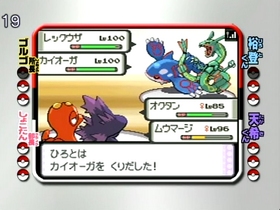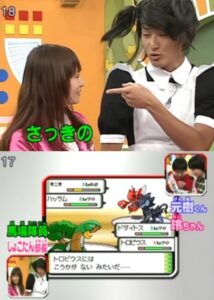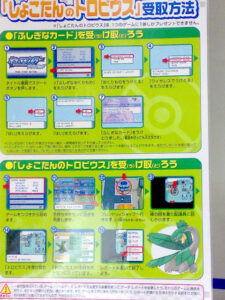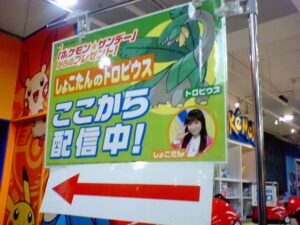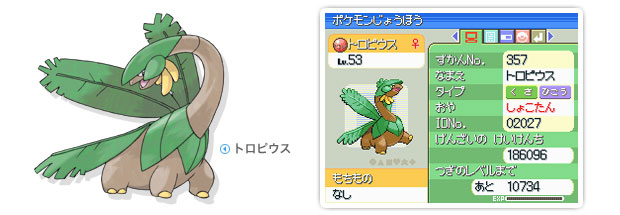On the spectrum of Japan’s famously weird variety TV shows, Pokémon Sunday ranks as rather tame. Still, as a kid’s programme co-hosted by five professionals comedians, it had its fair share of eye-popping moments. Such as when one of its resident male entertainers cross-dressed as a café maid for an episode. Only in Japan! But let’s backtrack a little. What exactly was Pokémon Sunday?
Well, to the Japanese schoolchildren glued to their parents’ TV screens every Sunday morning between 7:30AM to 8:30AM, Pokémon Sunday (ポケモン☆サンデー) was the premier funtertainment gateway to the Pokémon universe. With an emphasis on fun. Words fail to capture the quintessentially Japanese offbeat character of the show, and I invite you to watch some fragments for yourself to match picture with description.
Anyhow, Sunday’s hourlong programming traditionally kicked off with a 20-minute Pokémon anime episode re-run. After this followed the heart of the show: an unpredictable hodgepodge of light-hearted studio segments presided by over by the lovely Shoko “Shokotan” Nakagawa, who got her big career break presenting Sunday. The show’s five resident comedians could indulge their theatrical instincts here (more on them momentarily), soliciting laughs in free-flowing conversions revolving around some challenge, contraption or thingamabob only loosely related to Pokémon – if at all. This action went down under the watchful eye of the shows’ two costumed mascots: a Chimchar whose job description limited it to bouncing up and down in an unfailing expression of uncontainable excitement, and a stern-faced Lucario who, though not visibly doing much, evidently supervised the goings-on with quiet (dis)approval in his formal capacity of show director.
After these initial skits, a precorded video clip would be shown of Sunday’s cast traversing the country to conduct “field research” on a subject that dovetailed with whatever had been discussed in the studio. More often than not, the show’s trio of junior comedians took up this task, presenting their findings in silver-suited, inimitable style. Finally, a return to the studio would be made for Sunday to entertain special guests, usually children who had been invited to make battle alternating with the occasional VIP. Synchronised Pokémon song and dance led by Shokotan (e.g. here) closed out the programme. Pokémon Sunday aired for seven consecutive years (2004-2010), a good portion of which in this format, and with Shokotan as presenter-host.1 Therein preceded by Becky (see below). Altogether it was a hugely entertaining romp even for an adult Pokémaniac, and it’s difficult to overstate the popularity of this show in Japan.
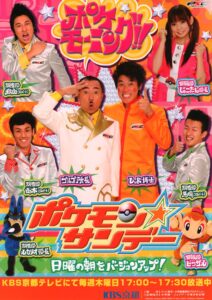 Let’s look at the stars of these studio segments a little more closely. Sunday’s comedy was not the work of amateurs. All five performers were (and continue to be) part of established cabaret acts, with the most senior pairing that of Golgo Matsumoto and Red Yoshida, the two halves of manzai stand-up duo “TIM”. Golgo had a fairly large part on Sunday, doubling as the show’s titular ‘chief’ and co-presenter to Shokotan. He is easily identified from his flamboyant white and gold suit adorned with Pokéballs and his Chaplin-like miniature moustache (see poster over side). Yoshida’s Sunday persona was that of “Professor Red” who, invariably clad in an orange longcoat with cheeks painted red, acted as the show’s nutty intellect and in so doing counterbalanced Golgo’s comedic presence. The true goofiness resided with Baba, Ariyama and Yamamoto of comedy act “Robert”. (I’m aware this is a lot of names to take in, but bear with me, because these guys are relevant to our story.) The trio typically sported matching silver glittery suits while on Sunday – that is, when not doing what they did best: to dress up as anything imaginable. Crasher Wake, sushi chef, police officer, karate kid, Sherlock Holmes, plus a bewildering array of cross-dress outfits; whatever getup you can conjure up in your mind’s eye, they probably donned it at some point. On occasion these outfits were functional and / or relevant in illustrating the talking points at hand; other times they served purely as giggle factor.
Let’s look at the stars of these studio segments a little more closely. Sunday’s comedy was not the work of amateurs. All five performers were (and continue to be) part of established cabaret acts, with the most senior pairing that of Golgo Matsumoto and Red Yoshida, the two halves of manzai stand-up duo “TIM”. Golgo had a fairly large part on Sunday, doubling as the show’s titular ‘chief’ and co-presenter to Shokotan. He is easily identified from his flamboyant white and gold suit adorned with Pokéballs and his Chaplin-like miniature moustache (see poster over side). Yoshida’s Sunday persona was that of “Professor Red” who, invariably clad in an orange longcoat with cheeks painted red, acted as the show’s nutty intellect and in so doing counterbalanced Golgo’s comedic presence. The true goofiness resided with Baba, Ariyama and Yamamoto of comedy act “Robert”. (I’m aware this is a lot of names to take in, but bear with me, because these guys are relevant to our story.) The trio typically sported matching silver glittery suits while on Sunday – that is, when not doing what they did best: to dress up as anything imaginable. Crasher Wake, sushi chef, police officer, karate kid, Sherlock Holmes, plus a bewildering array of cross-dress outfits; whatever getup you can conjure up in your mind’s eye, they probably donned it at some point. On occasion these outfits were functional and / or relevant in illustrating the talking points at hand; other times they served purely as giggle factor.
In addition to this often, eh… extroverted brand of entertainment, the show had a modest community outreach and news provision function. Sunday’s popularity and close connections to GameFreak and The Pokémon Company meant that, from time to time, big Pokéworld reveals happened live on the show. Pokémon Black & White were famously first announced on Sunday. Zoroark’s silhouette was revealed there. Daisuki initiatives like Valentine’s Magikarp were promoted on air. And for a time, regular interactions with the big kahunas at GameFreak became the norm, with company director Masuda appearing on the show every so often to playfully make battle and share development updates. It can only have benefited the show’s viewership numbers that Sunday could drop scintillating new Pokémon information unexpectedly and at any time!
Sunday’s intensely popular battle segment too, attracted a lot of viewers. Shokotan, Chief Golgo and all the supporting cast regularly participated in the weekly recurring feature that was hosts versus guests 2-on-2 double battles, played out in either Diamond & Pearl or Wii’s Pokémon Battle Revolution.2 Double battles were a feature newly introduced in Gen4. Youngsters could apply to be invited on the show and take a genuine shot at challenging the hosts’ variable and sometimes very-beatable teams. The kids certainty had no qualms about fielding tremendous raw power with a Dialga and Palkia (ep. #122), or Kyogre and Rayquaza (ep. #128)! Miraculous plays went down every so often that invited much enthusiastic discussion and analysis on Japanese forums and message boards. Remember, this was before “social media” existed. ‘Twas a glorious era.
In true franchise spirit, each of Sunday’s six entertainers forged canonical bonds in the heat of battle with certain of their Pokémon. Over and over such personal favourites were fielded, either out of their owners’ primordial love for particular species (think Masuda’s Psyduck!), or because these Pokémon evinced an uncanny and improbable ability to win matchups they shouldn’t. For example, Chief Golgo’s “Miracle” Octillery rose to nationwide fame after its Focus Band activated twice consecutively in a battle, allowing it to KO a vastly superior Latios while clinging to life at 1HP. And Hiroshi Yamamoto’s Whiscash somehow bested a Dialga it had absolutely no business defeating. The Sunday TV audience relished such epic moments, and these standout Pokémon rapidly became synonymous with their celebrity masters. It was perhaps inevitable, then, that at peak popularity of both hosts and show, these battle-hardened yet beloved creatures should be immortalised and replicated as event Pokémon to be shared with fans all around Japan.
Right. Now that you have a sense of what Sunday entailed, let’s take a deep dive into these homage Pokémon, shall we?
—–
Sunday Special #1: Shokotan Tropius, February 3-12, 2007
Inseparable though Shoko Nakagawa has become from Pokémon Sunday and successor shows Pokémon Smash! and Pokémon Get☆TV, she was not the show’s original presenter. Rather, British-Japanese talento Becky helmed Sunday from its inception in October 2004. By all accounts, Becky did a fine job. But it wasn’t until Shoko (stage name Shokotan)3 しょこたん took the reins in October 2006 that Sunday exploded in popularity. To be fair, the timing was fortuitous: with the release of Diamond & Pearl in September, the franchise had woken from a multi-year dormancy to reclaim Japan’s video game spotlight. An uptick in Sunday viewership was therefore to be expected. Even so, her bubbly personality and girlish good looks meant that Shokotan was an immediate hit with kids and Pokéfans alike, and fortified by her persona Pokémon Sunday made the most of the nation’s renewed love for Pokémon to carve out an enduring niche for itself. Shoko Nakagawa made Sunday, and Sunday made Shokotan.4 Shokotan has since proved herself to be truly multi-talented, showcasing her skills as an illustrator, singer, and voice actress over the years. She remains one of Japan’s most popular media personalities today; follow her on her YouTube channel here.
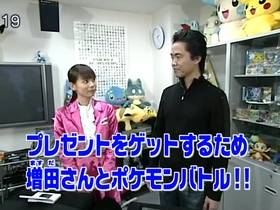
No win, no Shoko-Mon! Shokotan and Masuda-san discuss terms. Note the Manaphy plush in the background. Still from: Pokémon Sunday #120, via pocketmonsters.net
In the months following Diamond & Pearl’s September 2006 release, she and her follow Sunday staffers were regulars at GameFreak’s Tokyo offices. Shokotan had first paid a solo televised visit to the company in December 2006 (episode #114) to make battle with GameFreak graphic designer Takao Unno and investigate the art of music composition for Pokémon games with D&P director and composer Masuda.5 On the subject of Masuda as a creator of Pokémon music, see Concert Chatot. Some weeks later, she was back. In the episode aired January 28, 2007 (#120), Shokotan again journeyed to GameFreak, this time to battle Masuda-san. This wasn’t to be any old casual showdown, Sunday told viewers. At stake was the explicit right for Shokotan to distribute a special Pokémon of her choosing to fans around the country. No win, no Shoko-Mon!
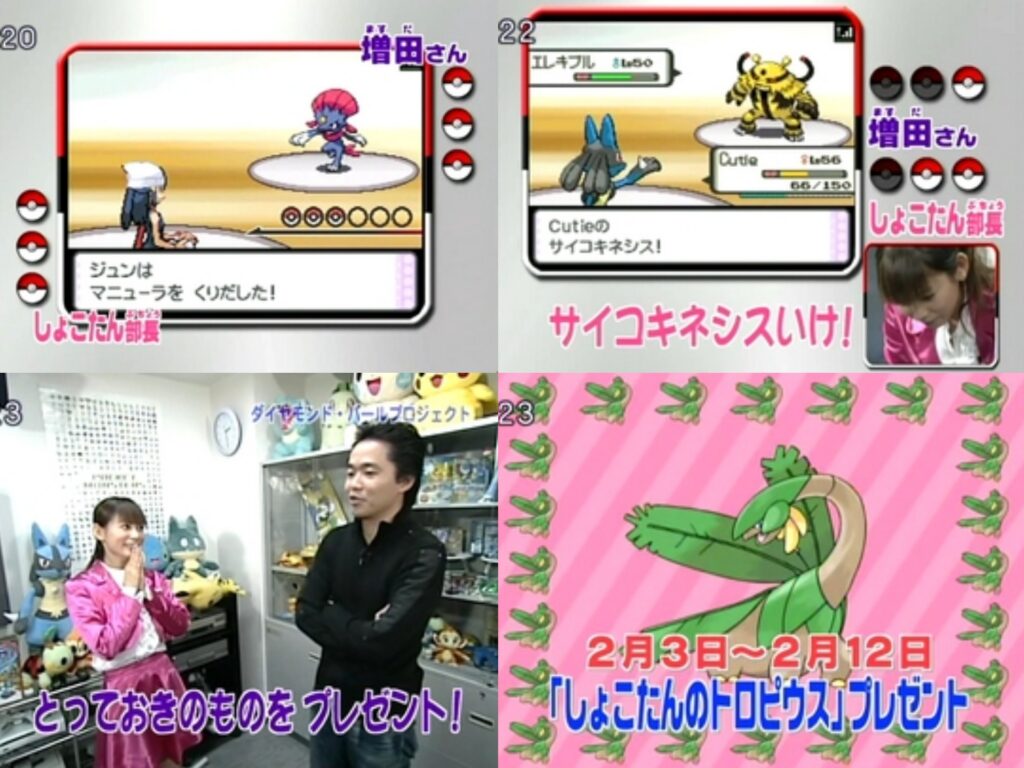
Clockwise, from top-left: (1) Jun sends out Weavile; (2) “Cutie” uses Psychic; (3) Tropius revealed; (4) A present is won! Stills from: Pokémon Sunday #120, via pocketmonsters.net
As was customary, Sunday broadcast the entire battle. In this 3-versus-3 singles engagement, Masuda battled with his personal save, OT ジュン (Jun). Was this the same savefile that would shortly produce 30 GTS Psyduck? Ah… If we only knew. Masuda fielded Weavile, Magmortar, and Electabuzz, the last two of which looked suspiciously like 2006 Battle Festa’s “Strongest [in] Class” Magmortar and Electivire (see here) that were still available from participating stores when the episode aired. Shokotan brought a team comprised of Purugly, a Lucario nicknamed “Cutie” (in Roman letters) and an unspecified third Pokémon that viewers never got to see… Because Shokotan’s first two absolutely ripped through Masuda’s squad! Shoko’s Purugly made short work of both Masuda’s leading Weavile and the Magmortar that came out next; Masuda’s closer, Electivire, launched a brave last-ditch offensive and succeeded in knocking out Shokotan’s resilient Purugly, but was stopped dead in its tracks by Lucario’s hard-hitting Psychic. (Yes, Shokotan ran Psychic on her Lucario.) Not a good showing there, Junichi!
Shokotan emerging victorious, she “earned the right to distribute a present”. Hurray! Which, the episode revealed, would be a Tropius. Ironically, her winning team had not starred any Tropius,6 It may have sat out the battle on the reserve bench, of course. and keen readers will have noticed that I referenced no Shokotan signature Pokémon in this article’s intro – and that’s because, at the time of the Shokotan-Masuda battle, she didn’t have one! Unlike later “Sunday Specials” that immortalised the livestage heroism of Whiscash and Octillery which just happened to be owned by Yamamoto and Chief Golgo, this Tropius was conceived largely to celebrate the popularity of Shokotan herself. Viewers weren’t to catch a first glimpse of the bananasaur in action until Sunday episode #121 that aired a week later on February 4th, when Shokotan and Hiroyuki Baba (dressed up as a café maid, naturally) joined forces to double-battle two kids, securing a Team Sunday victory.7 I took a deep dive into the Pokémon Sunday archives to make sure I’m correct on the causality. And I believe I am – I truly could not find Shokotan battling with her (or any) Tropius in the 20-odd episodes leading up to the giveaway.8 Note that this episode also contained an instructional segment on how to use the GTS, perhaps to prepare kids for the upcoming Magikarp of Love GTS event, which was promoted an episode later (#122). For screenshots see: https://www.pocketmonsters.net/episodes/viewep/815/Pictures Only post hoc, then, did Shokotan and Tropius become synonymous.
Not that this mattered in any way. The magic of Shokotan was such that Japanese kids would have settled for a Weedle with her name on it. To illustrate, blogger “yaboratory” described how his four year-old son, after watching the February 4 broadcast, begged his dad to collect Shokotan’s Tropius. (Which, being good father that he was, he duly did at PC Yokohama.) And it wasn’t just children who were genuinely excited. As with so many of Japan’s talents and idols, Shokotan developed a sizeable fanbase among (young) adults who weren’t about to let slip this opportunity to receive a tangible gift more or less directly from the superstar they admired.9 Take blogger “hiromin”, who admitted: “I’m a Shokotan fan and I started Pokemon because I wanted this (Tropius).” Japanese: “っていうか、しょこたんファンの私はこれが欲しくてポケモン始めたという・・・”, at: https://web.archive.org/web/20080930084747/http://yaplog.jp/hiromin/archive/885 Pokémon enthusiasts, too, enjoyed the freebie: Tropius marked only the second-ever time that Sunday had ventured to dip its toe into the world of event distributions (after 2005’s highly exclusive Wobbuffet), and it therefore represented a not-to-miss occasion from a collector’s perspective. Those who desperately wanted Tropius had to make hasty arrangements to pick it up, however, as it was available for a mere 10 days (February 3-12) at the nine PokéCenter and Pokémon Town locations nationwide.10 To be precise, at PokéCenters Tokyo, Yokohama, Osaka, Nagoya, Fukuoka, Sapporo, as well as the Pokémon Towns in Yoshida, Kurashiki, and Utsunomiya.11 Japan’s PokéCenters and Towns were distributed rather unevenly in a geographic sense, and that collection was limited to these locations much annoyed bloggers like “pokemonbiog” and “inbawhite”, both of whom faced the prospect of making a long trek to a distribution point in another prefecture, or give up on claiming Tropius. See: http://pokemonbiog.blog90.fc2.com/blog-entry-11.html; and https://web.archive.org/web/20070320054451/http://inabawhite.blog77.fc2.com/blog-entry-227.html
So! Excited youngsters accompanied by their guardians, parents on collection-duty on behalf of their offspring, mature Pokéfans out to satisfy their own curiosity, and fanboying (young) adults all jointly descended on Japan’s PokéCenters in early February 2007. And there they found a wealth of promotional material to communicate the initiative. Front-facing windows were decorated with special posters (see image). Sunday banners hung from ceilings to point visitors in the correct direction. And staffed assistance booths had been set up to help with redeems where necessary. Guests also found the Centers crowded – very crowded, in some instances. Blogger “eggplant” at PC Nagoya reported [LINK] six or seven people in line at opening time on a weekday. “Alleplatz” at PC Osaka noted how “even though it was a weekday morning, many moms and dads were lined up.” Yet this paled in comparison to visitor counts during the two weekends of Tropius’ availability. Blogger oyako found PC Osaka “extremely crowded” on a Sunday morning. Similarly “yuki-gootara”, who went to PC Nagoya with his family on Sunday February 4 after his young son pleaded him for a Shokotan Tropius, observed the place to be “really full of kids with DS”.
To limit the relentless queuing that had plagued the Festa MagBuzz distribution, Tropius was made available wirelessly. That this was so seems pretty unequivocal. Wireless event downloads were still a novelty at this stage, and many commentators noted its unprecedented convenience. For instance, blogger “galleon.air” at PC Osaka compared how “in the past, in order to distribute such special items, we had to form a line and each had to have the [distribution] ROM inserted individually. [N]ow it’s easy to distribute wirelessly. Just go to the crowd and push a few buttons. It’s a lot easier.”12 Writing: “昔はこういう特別アイテムの配布は行列を作って、1台1台ROMを差し込んで配布してもらっていたけど、今はワイヤレスで楽々配布。人混みに寄っていって2つ3つボタンを押すだけ。ずいぶん楽だ。” Blogger “gamp” at PC Yokohama wrote something similar, noting how “Shokotan Tropius does not require queueing because it is in a state of being spilled by distribution.”13 Writing: “と言うか、しょこたんトロピウスは配信で垂れ流されている状態なので実際は並ばなくてもよいんですよ。” By contrast, the line for collecting the concurrent DVD Manaphy stretched out “hundreds of meters around the building.”14 Not that “gamp” could escape these queues, as he was also collecting his blue blob. It’s worth noting that galleon-air and gamp both visited their respective PokéCenters on weekends: gamp on Saturday February 3, galleon on Sunday February 4. “Pikarinchu” at PC Nagoya, too, observed lengthy queues, but after a flash of panic thinking they’d be stuck there for hours heaved a sigh or relief on learning that the lines were, in fact, to collect DVD voucher Manaphy: “I was surprised to hear that the line was the place to receive Manaphy, and receiving Tropius was through ‘communication’, so it’s okay not to queue.” Others were to get sore legs, not her! Pikarinchu’s pictures at PC Nagoya include a photograph of a poster containing extensive step-by-step instructions on how to pull Tropius from the ether (see image).15 Pikarinchu never makes explicit which city’s PokéCen she visited; Nagoya’s unique logo with mascots of Pikachu, Mudkip, and Chikorita gives it away, however.
So riddle me this. While many bloggers downloaded Tropius remotely, others claim they waited in line specifically to receive it. “Inside-games” for example went to PC Tokyo on the first day of Tropius’ distribution (Feb 3), and observed some 200 people queueing for about 30 minutes to, by his description, explicitly get Tropius. He himself too “lined up” to get the Pokémon, while also noting “many people communicating in front of the store.” One “asami” at PC Tokyo recorded how in the afternoon of Sunday February 4, signposted Tropius delivery waiting times were two hours! Which sounds incredible. More befitting of cartridge-based distributions of old, such queues cannot have formed to receive Tropius wirelessly. Can they?
Well… Here’s where the historical record is a bit spotty. Just one solitary source, blogger “torogamer”, touched upon what certainly sounds like (limited) slot-2 Tropius distribution at the PC Nagoya. Describing his personal experience, he noted: “[S]pecial distribution was also (my italics) done a corner of the cash register. While I waited, the clerk handled the distribution work for the remaining three softwares, so it was easy.”16 Writing: “特別配布も、レジの一角でおこなわれていました。私がもたもたしている間に、係員のおねぇさんが、残りの3つのソフトに配布作業をすませてくれちゃったりして、楽だったなぁ。 If that’s a little ambiguous, in his coverage of that second Sunday special, Yamamoto Whiscash, he reflected on event distribution mechanics once more, recording in explicit contrast to Shokotan Tropius:
“Last time … the lady in charge of each software manually inserted a wondercard. This time, the distribution period coincides with Spring Break, so manual work is not good. The Whiscash data comes from the installed transmitter on the radio waves. You don’t have to wait in line to get a wondercard. If you go near the distribution location and download it yourself, it’s OK. I inadvertently searched for the ‘tail of the queue’ until I realised that.”17 In the original Japanese “前回、「しょこたんのトロピウス」の時は、ソフトごとに担当のおねぇさんが、手作業で「ふしぎなカード」を入れてくれました。今回、配布期間がもろ春休みにぶつかることから、手作業はボツ。設置された発信機から、電波に乗ってナマズンのデータがやってきます。「ふしぎなカード」をもらうために、行列して待つ必要がありません。配布場所の近くまで行って、自分でダウンロードすればOK。 ・・・ということがわかるまで、うっかり「行列の尻尾」をさがしてしまいました。
Is that watertight evidence? I’m not sure. We have no reason to doubt the veracity of this respected Pokéblogger’s contemporaneous account. Yet no pictures, photographs, marketplace listings, or any other proof of a dedicated Shokotan Tropius distribution cartridge exists. Even the committed recordkeeper Pikachuftt had to concede that they “received the gift from wireless, so I don’t have [pictures of the] double-slot cassette that I always had at the time of distribution.”18 “おくりものをうけとるでワイヤレスからうけとるです。なので、いつも配布のときにあった、ダブルスロットのカセットがないです。” at: http://pikachuftt.blog82.fc2.com/blog-entry-100.html Was PC Nagoya an anomaly? Who is to say… Either way, to the extent that Tropius slot-2 distribution took place, it cannot have been the intended primary delivery method – think the high-visibility Tropius instructional WiFi posters!
Rather, I think, if we want to explain the ostensibly bizarre phenomenon of queuing for a wireless download, we need to look towards three other factors. First are the exigencies of Diamond & Pearl’s WiFi communication features. For reasons known only to GameFreak, the games’ Mystery Gift functions were not accessible by default. To unlock the relevant menus, one had to first to confide a universal EasyChat passphrase to an in-game NPC stationed in Jubilife City.19 “EVERYONE HAPPY” & “WI-FI CONNECTION”, the Japanese equivalent being みんな ハッピー Wi-Fi つうしん Nowhere in the games was this process clearly explained. (Did Pokémon Sunday communicate this secret to players, by any chance?) Considering that Tropius was Gen 4’s first mass local wireless event, it’s likely that many parents arrived on-site blissfully unaware that preparatory steps were required to collect the Pokémon for their young ‘uns, thus requiring them to queue for assistance. Alleplatz’ observation of “many moms and dads lining up” certainly rhymes with this theory.
A second factor was how despite the prominence of instructional posters, a subset of visitors failed to notice the change-up in procedure. It caught out our old acquaintance bany.bz who, stopping by Pokémon Town Utsunomiya, inquired at the store clerk how to receive Tropius, only to be told delivery was automated over wireless.20 そして、ふしぎなおくりものを受け取ろうと店員さんに声をかけたら、「オートで配信されてますから」って Oops!
Lastly, so popular was the event, and those who required help sufficiently numerous, that queues formed simply to get in range of the router. Yeah… It’s crazy. Wrote “hiromin” at PC Tokyo: “It’s so crowded that it says to wait an hour each for data communication and PokéCenter entrance. […] I quietly lined up in the data communication line. If you wait while advancing the game, you will get there in about 20 minutes. Data communication is done wirelessly to about 20 people at a time, so it’s fast.”21 See: https://web.archive.org/web/20080930084747/http://yaplog.jp/hiromin/archive/885 And noted “ginn1919”, who visited PC Tokyo on Saturday February 3: “We arrived at PC Tokyo at 09:45. The line waiting for delivery extended from the store all the way to the crossroads. But the lines moved quickly and I got a Tropius at 10:00. After all, it was distributed to about 10 people at once by wireless communication.”22 “私たちがポケモンセンター東京に着いたのは9時45分。配信待ちの列はお店からずっと伸び、十字路を右に曲がったところまで続いていました。でも進むのは早く、10時にはトロピウスをゲット。だってね、10人ぐらいにいっぺんにワイヤレス通信で配布してくれるのですもの。” See: https://blog.goo.ne.jp/ginn1919/e/504c7be4de12c5ecc8cefad11ac7467c Mass how-to instruction of small 10-20 people groups was evidently done to obviate the need for continual individual explanation.
Enamoured by the prospect of receiving a Shokosaur, most attendees didn’t seem to mind the wait. For many Pokéfans, this was their first exposure to the magic of wireless distribution. Children in particular enjoyed the ritual of synchronised Tropius redemption. Blogger “ginn1919” described how at PC Tokyo, a female staffer would summon nearby children holding D&P games, walk them through the Mystery Gift steps, and then instruct them to press “confirm” in unison. “When Tropius was delivered all at once … the children’s voices said “Wow!”. If I’m honest, everyone did.”23 Words of ginn1919, full quote is:”「ゲームを持ったお友だちはこっちに来てね~」と言うおねえさんの元へ集まる子どもたち。一緒にくっついていく私。いっせいにトロピウスが配信されて、自分のゲーム画面にトロピウスが映ると「わ~」と子どもたちの声。素直だわ、みんな。” How wholesome is that?! I know I, too, would have been impressed to see 20 screens light up at once in a feat of glorious Pokémon synchronicity. Slot-2 distribution, eat your heart out! The only thing that could have improved the experience was an appearance by Shokotan herself. But alas, that was not to be.
Onto the Pokémon itself. We’ve already covered how Tropius had Shokotan’s name (しょこたん) for its OT. It came in a crimson Cherish Ball, which was a new event-exclusive type of Pokéball freshly introduced in Diamond & Pearl. For some reason Tropius was locked to female – “Director Shokotan may be particular about girl Pokémon”, torogamer speculated. Oddly, the bananasaur came at Lv.53; I’m not sure whether these digits had any special significance to Shoko, to Sunday, or to the Pokémon Tropius, or whether this uneven number was chosen at random. Its moveset was a fairly standard battle-ready Air Slash / Synthesis / Sunny Day / Solarbeam.
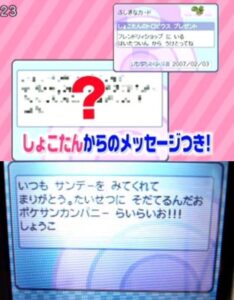
Sunday teases Shokotan’s message (top). It reads (bottom): “Thank you for always watching Pokémon Sunday”, ending on her trademark yell “rairai-o”! Still from: Pokémon Sunday #120, via pocketmonsters.net
Players who examined the Mystery Gift menu closely found that, like all event Pokémon, downloading Tropius left a wondercard. And on the back of this digital business card-like trinket was printed a personal note of gratitude from Shokotan (see image). This upbeat message closed out with what is apparently a trademark yell “rairai-o!” (らいらいお!). I was initially dumbfounded by this; after doing a little digging, I learned that Shoko is known for her wacky exclamations and catchphrases… Her use of language is sufficiently creative that a Wikipedia page exists for Shokotan-speak. Shoko’s staunch fans embrace and adopt these idiosyncrasies, as evident from the many bloggers I found enthusiastically referencing and repeating her number one shout “gizaureshisu!” (ギザウレシス!).24 For example bloggers “satopie”, “nakagawashouko” and “kuma-hime”, respectively at: https://satopie.typepad.jp/blog/2007/01; and http://nakagawashouko.sblo.jp/s/article/3334077.html; and http://kuma-hime.seesaa.net/article/186324489.html A shout that, as far as I can tell, doesn’t mean anything at all. So, eh… The more you know!
Part 2 in this Pokémon Sunday series, about the unlikely MVP Yamamoto Whiscash, continues here. Part 3 on the improbable heroics of Golgo’s Octillery is found here.
- Harvest Moon 3 (2001) - March 5, 2020
- Pokémon Trading Card Game 2 (2001) - February 5, 2020
- Yu-Gi-Oh! Dark Duel Stories (2002) - January 5, 2020

